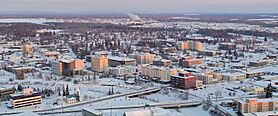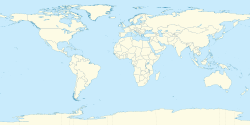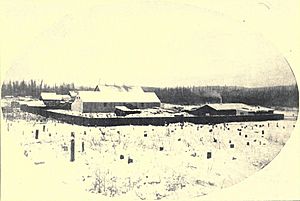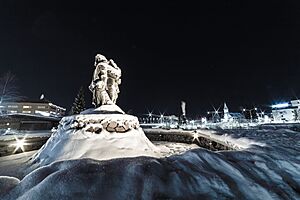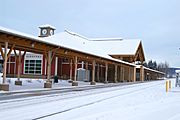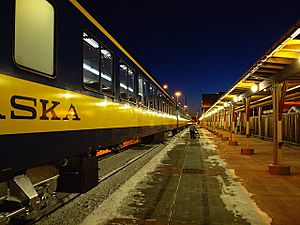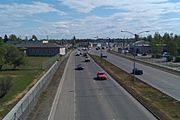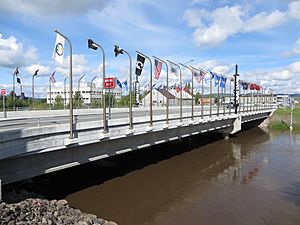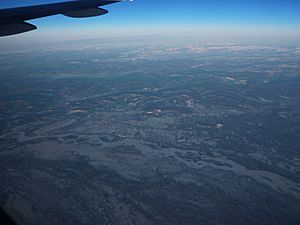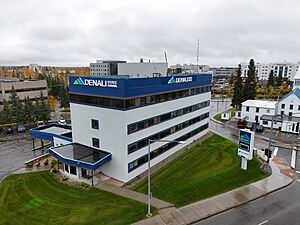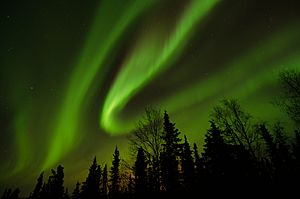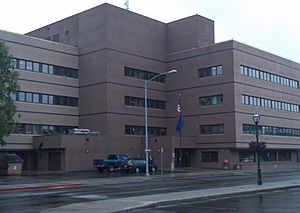Fairbanks, Alaska facts for kids
Quick facts for kids
Fairbanks, Alaska
|
|||||
|---|---|---|---|---|---|
|
Aerial view of downtown in 2020
Constitution Hall at the University of Alaska
Mary Lee Davis House
Old Federal Building
Downtown at night along the Chena River
Fairbanks Depot
|
|||||
|
|||||
| Nickname(s):
"Golden Heart City", "Golden Heart of Alaska"
|
|||||
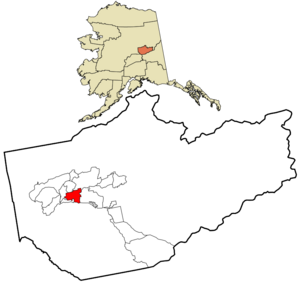
Location of Fairbanks within Fairbanks North Star Borough
|
|||||
| Country | United States | ||||
| State | Alaska | ||||
| Borough | Fairbanks North Star | ||||
| Incorporated | November 10, 1903 | ||||
| Founded by | E. T. Barnette | ||||
| Named for | Charles W. Fairbanks | ||||
| Government | |||||
| • Type | Home rule city | ||||
| Area | |||||
| • City | 32.62 sq mi (84.5 km2) | ||||
| • Land | 31.75 sq mi (82.2 km2) | ||||
| • Water | 0.88 sq mi (2.3 km2) | ||||
| Elevation | 446 ft (136 m) | ||||
| Population
(2020)
|
|||||
| • City | 32,515 | ||||
| • Density | 1,024.22/sq mi (395.45/km2) | ||||
| • Urban | 71,396 | ||||
| • Metro | 95,655 | ||||
| Demonym(s) | Fairbanksan | ||||
| GDP | |||||
| • Fairbanks North Star | US$5.532 billion (2022) | ||||
| Time zone | UTC−9 (AKST) | ||||
| • Summer (DST) | UTC−8 (AKDT) | ||||
| ZIP Codes |
99701, 99702, 99703, 99705, 99706, 99707, 99708, 99709, 99710, 99711, 99712, 99714, 99716, 99725 (Ester), 99767, 99775-(UAF), 99790
|
||||
| Area code | 907 | ||||
| FIPS code | 02-24230 | ||||
| GNIS feature ID | 1401958 | ||||
Fairbanks is a city in Alaska, United States. It is the biggest city in the Interior part of the state and the second largest overall. In 2020, about 32,515 people lived in Fairbanks. The wider area, called the Fairbanks North Star Borough, had about 95,655 people. This makes it the second largest city area in Alaska, after Anchorage. Fairbanks is the northernmost major city in the United States. It is about 196 miles (315 km) by road south of the Arctic Circle.
Fairbanks started as a trading post in August 1901, founded by E. T. Barnette along the Chena River. When gold was found nearby, many miners came, starting the Fairbanks Gold Rush. The town grew quickly, and in November 1903, people voted to make Fairbanks a city. Barnette became its first mayor. The city's population dropped after World War I but grew again during the Great Depression because gold prices went up.
In the 1940s and 1950s, Fairbanks became important for building military bases during World War II and the Cold War. Fort Wainwright, an army base, was built east of the city starting in 1938. After oil was found in Prudhoe Bay Oil Field in 1968, Fairbanks became a key supply point for the oil fields and the Trans-Alaska Pipeline System. Today, tourism is also a big part of Fairbanks' economy.
Fairbanks is located in the Tanana Valley, right on the Chena River. The Tanana River forms the city's southern edge. Fairbanks is known as the coldest city in the United States with a population over 10,000. In January, the average temperature is about -8.3°F (-22.4°C), while in July, it's around 62.9°F (17.2°C). In winter, cold air gets trapped in the valley, making it very chilly.
Fairbanks is home to the University of Alaska Fairbanks, which opened in 1917. The Fairbanks International Airport is also nearby. It's special because Fairbanks is the smallest U.S. city with regular non-stop international flights.
Contents
- Exploring Fairbanks' Past
- What is Fairbanks Like?
- Weather in Fairbanks
- People of Fairbanks
- Fairbanks' Economy
- Fun Things to Do in Fairbanks
- Sports and Recreation
- Parks and Outdoor Fun
- Education in Fairbanks
- Media and News
- City Services
- Law Enforcement
- Famous People from Fairbanks
- Sister Cities
- See also
Exploring Fairbanks' Past
Early Native American Life
Athabascan people lived in the Fairbanks area for thousands of years. They used the land for seasonal hunting and fishing. Archaeologists found an old camp at the University of Alaska Fairbanks that is about 3,500 years old. Even older remains were found deeper down. This suggests that people came to North America from Asia a very long time ago.
How Fairbanks Was Founded
Captain E. T. Barnette started Fairbanks in August 1901. He was on his way to set up a trading post further east when his steamboat got stuck on the Chena River. He and his supplies were left on the riverbanks. Gold miners, like Felix Pedro, saw the steamboat's smoke and met Barnette. They convinced him that the area had gold. So, Barnette set up his trading post right there. Soon, many gold prospectors gathered in Fairbanks, digging for gold.
Later, the settlement was named after Charles W. Fairbanks. He was a senator from Indiana and later the Vice President of the United States.
In the early days, the Tanana Valley was an important farming area for Alaska. Farmers grew crops to feed the growing population. Even today, some farming happens southeast of Fairbanks.
Growth and Challenges
Starting in 1939, the building of Ladd Army Airfield (now Fort Wainwright) brought many people and jobs to Fairbanks. This growth continued after World War II. The U.S. military has remained a strong presence in the city.
Fairbanks has faced several floods over the years. In 1967, heavy rain caused the Chena River to flood almost the entire town. This led to the creation of the Chena River Lakes Flood Control Project. This project built the Moose Creek Dam to protect the city from future floods.
Fairbanks' Railroad Story
After gold mining grew, miners wanted a railroad to connect the river docks to the gold mines. The Tanana Mines Railroad started in 1905. In 1907, it became the Tanana Valley Railroad. This railroad grew until 1910, when the gold rush slowed down.
In 1914, the U.S. government decided to build the Alaska Railroad system. In 1917, the Alaska Railroad bought the Tanana Valley Railroad. A new rail line was built, connecting Fairbanks to Nenana. In 1923, President Warren G. Harding hammered in the final spike, completing the line. Fairbanks became the northern end of this important railway.
Today, the Alaska Railroad mainly carries freight. In summer, it also runs tourist trains. A new terminal opened in 2005, replacing the old one in downtown Fairbanks. There are plans to extend the rail line to Delta Junction.
Roads and Highways
When Fairbanks was founded, people arrived by steamboat. In 1904, a trail was built to connect Fairbanks to the outside world. This trail became the Richardson Highway in 1910. It was later improved for cars and paved in 1957.
More roads were built to connect Fairbanks. The Steese Highway opened in 1927, linking Fairbanks to the Yukon River. In 1942, the Alaska Highway connected the Richardson Highway to Canada. This allowed people to drive from the rest of the United States to Fairbanks.
In the 1960s and 1970s, new roads were built to reach the oil fields. The Elliott Highway and the Dalton Highway helped transport supplies. The George Parks Highway was built in 1971, connecting Fairbanks to Palmer.
Most of Fairbanks' city streets were gravel until the 1950s. Paving began in 1953, and by the 1960s, most streets were asphalt.
What is Fairbanks Like?
Fairbanks' Landscape
Fairbanks is in the middle of the Tanana Valley, with the Chena River flowing through it. North of the city are hills that lead up to the White Mountains. The Tanana River forms the southern border. South of the river is a large marshy area called the Tanana Flats. On clear days, you can see the Alaska Range mountains from Fairbanks.
Many small streams and rivers flow into the Tanana River. In Fairbanks, the Chena River flows southwest into the Tanana. A waterway called Noyes Slough creates Garden Island, which is connected by bridges.
The city covers about 32.7 square miles (84.7 square kilometers). Most of this is land, with a small amount of water.
Location and Daylight

Fairbanks is very far north, close to the Arctic Circle. This means it has very long days in summer and very short days in winter. Around the summer solstice (June 20-21), Fairbanks gets almost 22 hours of sunlight! This is called the "Midnight Sun." In winter, around December 21-22, it only gets about 3 hours and 41 minutes of sunlight. Even after sunset in summer, it stays bright enough to see without electric lights.
Weather in Fairbanks
Fairbanks has a climate with long, very cold winters and short, warm summers. Snow usually falls from October to May. The first big snowfall often happens around October 1. The snow usually stays on the ground from mid-October until late April. Sometimes, snow can arrive early and heavily. For example, in September 1992, 8 inches (20 cm) of snow fell while trees still had leaves.
The average time without freezing temperatures is about 119 days, from September 11 to May 14. However, it can sometimes freeze in June, July, or August.
Fairbanks is the coldest city in the U.S. with a population of at least 10,000. The average temperature in January is -8.3°F (-22.4°C), and in July, it's 62.9°F (17.2°C). Temperatures can drop to -40°F (-40°C) about 7 days a year and rise to 80°F (27°C) about 13 days a year. The highest temperature ever recorded was 99°F (37°C) in July 1919. The lowest was -66°F (-54°C) in January 1934.
These extreme temperatures happen because of a few things:
- Temperature Inversions: In winter, cold air gets trapped in the low-lying Tanana Valley, while warmer air rises above the hills. This creates a huge temperature difference.
- Daylight: The amount of sunlight changes a lot between summer and winter due to Fairbanks' northern location.
- Wind Direction: Winds from the south can bring warm, moist air from the Gulf of Alaska, making temperatures much warmer. This is called a chinook wind.
Fairbanks also experiences other unique weather. In summer, smoke from wildfires can fill the valley. In winter, when it's very cold, ice fog can form. This happens when the air is too cold to absorb moisture, so water freezes into tiny crystals that hang in the air.
One of the most amazing sights in Fairbanks is the aurora borealis, also known as the northern lights. They are visible more than 200 days a year! However, you can't see them in summer because of the "Midnight Sun."
| Climate data for Fairbanks International Airport, Alaska (1991–2020 normals, extremes 1904–present) | |||||||||||||
|---|---|---|---|---|---|---|---|---|---|---|---|---|---|
| Month | Jan | Feb | Mar | Apr | May | Jun | Jul | Aug | Sep | Oct | Nov | Dec | Year |
| Record high °F (°C) | 52 (11) |
50 (10) |
56 (13) |
76 (24) |
90 (32) |
96 (36) |
99 (37) |
93 (34) |
84 (29) |
72 (22) |
54 (12) |
58 (14) |
99 (37) |
| Mean maximum °F (°C) | 29.7 (−1.3) |
35.4 (1.9) |
45.1 (7.3) |
61.9 (16.6) |
76.6 (24.8) |
85.1 (29.5) |
85.0 (29.4) |
80.0 (26.7) |
69.3 (20.7) |
54.8 (12.7) |
32.7 (0.4) |
32.2 (0.1) |
87.5 (30.8) |
| Mean daily maximum °F (°C) | 0.6 (−17.4) |
11.6 (−11.3) |
24.9 (−3.9) |
45.6 (7.6) |
62.1 (16.7) |
71.8 (22.1) |
72.7 (22.6) |
66.4 (19.1) |
55.3 (12.9) |
34.1 (1.2) |
12.3 (−10.9) |
4.3 (−15.4) |
38.5 (3.6) |
| Daily mean °F (°C) | −8.3 (−22.4) |
0.2 (−17.7) |
10.7 (−11.8) |
33.7 (0.9) |
50.3 (10.2) |
61.0 (16.1) |
62.9 (17.2) |
57.0 (13.9) |
45.8 (7.7) |
26.2 (−3.2) |
4.1 (−15.5) |
−4.3 (−20.2) |
28.3 (−2.1) |
| Mean daily minimum °F (°C) | −17.2 (−27.3) |
−11.2 (−24.0) |
−3.4 (−19.7) |
21.7 (−5.7) |
38.6 (3.7) |
50.2 (10.1) |
53.1 (11.7) |
47.6 (8.7) |
36.2 (2.3) |
18.4 (−7.6) |
−4.1 (−20.1) |
−13.0 (−25.0) |
18.1 (−7.7) |
| Mean minimum °F (°C) | −43.2 (−41.8) |
−36.0 (−37.8) |
−27.3 (−32.9) |
−2.4 (−19.1) |
26.2 (−3.2) |
40.2 (4.6) |
44.2 (6.8) |
36.1 (2.3) |
23.4 (−4.8) |
−2.9 (−19.4) |
−25.9 (−32.2) |
−36.5 (−38.1) |
−45.8 (−43.2) |
| Record low °F (°C) | −66 (−54) |
−58 (−50) |
−56 (−49) |
−32 (−36) |
−1 (−18) |
28 (−2) |
30 (−1) |
21 (−6) |
3 (−16) |
−28 (−33) |
−54 (−48) |
−62 (−52) |
−66 (−54) |
| Average precipitation inches (mm) | 0.61 (15) |
0.52 (13) |
0.40 (10) |
0.34 (8.6) |
0.54 (14) |
1.48 (38) |
2.26 (57) |
2.10 (53) |
1.35 (34) |
0.76 (19) |
0.74 (19) |
0.57 (14) |
11.67 (296) |
| Average snowfall inches (cm) | 10.2 (26) |
10.0 (25) |
6.5 (17) |
3.1 (7.9) |
0.9 (2.3) |
0.0 (0.0) |
0.0 (0.0) |
0.0 (0.0) |
2.3 (5.8) |
8.2 (21) |
12.5 (32) |
10.9 (28) |
64.6 (164) |
| Average precipitation days (≥ 0.01 in) | 8.7 | 6.9 | 5.7 | 3.7 | 6.2 | 10.8 | 12.8 | 13.5 | 10.7 | 9.8 | 9.5 | 8.8 | 107.1 |
| Average snowy days (≥ 0.1 in) | 10.2 | 8.3 | 6.7 | 2.6 | 0.6 | 0.0 | 0.0 | 0.0 | 1.3 | 8.3 | 11.2 | 10.4 | 59.6 |
| Average relative humidity (%) | 69.3 | 65.5 | 60.4 | 56.2 | 50.2 | 56.6 | 64.2 | 70.8 | 68.9 | 74.1 | 72.8 | 71.3 | 65.0 |
| Average dew point °F (°C) | −17.0 (−27.2) |
−11.9 (−24.4) |
−0.2 (−17.9) |
16.2 (−8.8) |
29.7 (−1.3) |
42.6 (5.9) |
48.7 (9.3) |
46.0 (7.8) |
34.5 (1.4) |
17.4 (−8.1) |
−3.8 (−19.9) |
−13.2 (−25.1) |
15.8 (−9.0) |
| Mean monthly sunshine hours | 54 | 120 | 224 | 302 | 319 | 334 | 274 | 164 | 122 | 85 | 71 | 36 | 2,105 |
| Source 1: NOAA (relative humidity 1961–1990) | |||||||||||||
| Source 2: Danish Meteorological Institute (sun, 1931–1960) | |||||||||||||
People of Fairbanks
| Historical population | |||
|---|---|---|---|
| Census | Pop. | %± | |
| 1910 | 3,541 | — | |
| 1920 | 1,155 | −67.4% | |
| 1930 | 2,101 | 81.9% | |
| 1940 | 3,455 | 64.4% | |
| 1950 | 5,771 | 67.0% | |
| 1960 | 13,311 | 130.7% | |
| 1970 | 14,771 | 11.0% | |
| 1980 | 22,645 | 53.3% | |
| 1990 | 30,843 | 36.2% | |
| 2000 | 30,224 | −2.0% | |
| 2010 | 31,535 | 4.3% | |
| 2020 | 32,515 | 3.1% | |
| U.S. Decennial Census | |||
Fairbanks first appeared in the U.S. Census in 1910 as Alaska's largest city. It became an official city in 1903.
In 2011, about 32,036 people lived in Fairbanks. The population of the wider Fairbanks North Star Borough was 95,655. Most residents were White (57.5%), with other groups including Black or African American (7.42%), Native American or Alaska Native (8.63%), and Asian (4.21%). About 11% of the population was Hispanic or Latino.
Many households (39.9%) had children under 18. The average age of people in Fairbanks was 28 years. About 26% of the population was under 18.
The average income for a household was about $55,409. About 10.5% of the population lived below the poverty line. Most adults (88%) had graduated from high school.
Fairbanks' Economy
Fairbanks' economy relies on several things. Doyon, Limited, a company that helps with oil services, is based here.
Taxes in the City
Fairbanks does not have a sales tax. It has a property tax, which helps pay for city and borough services. There are also special taxes on alcohol and tobacco, and a tax on hotel stays.
Fun Things to Do in Fairbanks
Fairbanks offers many attractions and events throughout the year. In summer, many tourists visit, often as part of cruise ship tours. They usually stay in local hotels and visit different places. During winter, tourism focuses on seeing the northern lights, ice carving shows, and winter sports. Many people from other parts of Alaska also visit Fairbanks for events.
Here are some popular attractions and events:
- Creamer's Field Migratory Waterfowl Refuge: A great place to see birds.
- Golden Days Parade: A fun parade held in July.
- Midnight Sun Game: A baseball game played on June 21 without artificial lights because it's still bright outside!
- Pioneer Park: A historical park with old buildings and museums.
- World Eskimo Indian Olympics: An event in July showcasing traditional Native Alaskan games.
- Tanana Valley State Fair: A fair held in July or August.
- World Ice Art Championships: An amazing ice sculpting competition in February.
Sports and Recreation
Fairbanks is a great place for winter sports like cross-country skiing and dog mushing. The city hosted the 2014 Arctic Winter Games in March 2014, a big event for northern athletes. It has also hosted national skiing championships. The Sonot Kkaazoot, a 50-kilometer ski race, is held here every year.
Fairbanks is also a starting or ending point for the Yukon Quest. This is a very tough 1,000-mile sled dog race. It switches its start and finish points each year between Fairbanks and Whitehorse, Yukon.
Hockey is popular in Fairbanks. The University of Alaska Fairbanks has a men's hockey team called the Nanooks. The Fairbanks Ice Dogs are a junior hockey team that plays at the Big Dipper Ice Arena.
The Alaska Goldpanners of Fairbanks is a summer baseball team. They play at Growden Memorial Park. This park is famous for the annual Midnight Sun Game, which has been played since 1906. It starts after 10 PM on the summer solstice and is played without lights!
Fairbanks is also the start and end point for the Yukon 800 speedboat race, held every June.
Parks and Outdoor Fun
Alaska State Parks manages the Chena River State Recreation Site. This 29-acre park in Fairbanks has a campground, trails, and a place to launch boats.
Education in Fairbanks
The Fairbanks North Star Borough School District runs the public schools in Fairbanks. The school board has 10 members who help make decisions about the schools.
The University of Alaska Fairbanks is located in the nearby College area. It is the first campus of the University of Alaska system.
Media and News
Fairbanks' main newspaper is the Fairbanks Daily News-Miner. It also has a weekly guide to entertainment. Other local papers include The Ester Republic and the student newspaper for the University of Alaska Fairbanks, the Sun Star.
Fairbanks has many radio stations. Some popular ones include KFAR 660 (talk radio), KCBF 820 (ESPN Radio), KUAC 89.9 (NPR), and KWLF 98.1 ("Wolf 98.1" for top 40 music).
Major TV channels in Fairbanks include KATN (ABC, Fox, The CW Plus), KUAC-TV (PBS), KTVF (NBC), and KXDF-CD (CBS). Cable TV is available from GCI, and satellite TV from Dish Network and DirecTV.
City Services
Getting Around
Bus Service
Since 1977, the Metropolitan Area Commuter System (MACS) has provided public bus transportation. Buses connect most of the city, with many routes meeting at the downtown transit center.
Air Travel
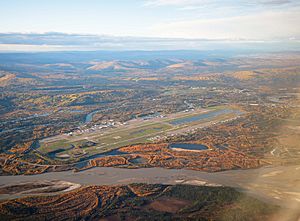
The Fairbanks International Airport is a key airport for air travel in Alaska. Many regional airlines use it as their main base. Commercial airlines also fly from Fairbanks to other parts of the U.S. and some international places. Fairbanks is the smallest U.S. city with regular non-stop international flights, with Condor operating flights to Frankfurt, Germany, in the summer.
Utilities and Power
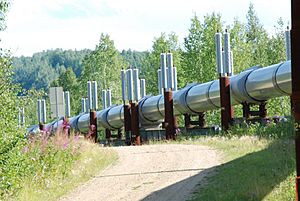
Electricity in Fairbanks is provided by the Golden Valley Electric Association (GVEA). Fairbanks is not connected to the main power grid of the rest of the U.S. and Canada. However, a power line connects Fairbanks to electric companies in Southcentral Alaska. GVEA used to have the world's largest rechargeable battery, which helped keep power stable during outages.
The University of Alaska Fairbanks has its own power plant that uses coal to provide electricity and heat to its buildings.
Telephone and Internet services are provided by companies like Alaska Communications (ACS) and General Communications Inc. (GCI). Two fiber optic cables connect Fairbanks for long-distance phone and Internet, one going to Anchorage and another to Valdez. A third cable connects to Prudhoe Bay.
Law Enforcement
The Fairbanks Police Department is the main police force for the city. They work to keep the community safe. The Alaska State Troopers also help the police department.
Famous People from Fairbanks
Many notable people have connections to Fairbanks:
- John Luther Adams (born 1953), a composer inspired by Alaska's nature.
- Lincoln Brewster (born 1971), a contemporary Christian musician.
- Susan Butcher (1954–2006), a famous dog musher who won the Iditarod Trail Sled Dog Race four times.
- Daryn Colledge (born 1982), a football player who won the Super Bowl with the Green Bay Packers.
- Denali Foxx (born 1992), a drag queen and figure skater who was on RuPaul's Drag Race.
- Vivica Genaux (born 1969), a well-known opera singer.
- Alex Hall (born 1998), an Olympic gold medalist in freestyle skiing.
- James C. Hayes (born 1946), the first African-American mayor of Fairbanks.
- Ruthy Hebard (born 1998), a professional basketball player for the Chicago Sky.
- Kevin Johansen (born 1964), a musician and singer-songwriter.
- Lance Mackey (1970–2022), a four-time winner of both the Yukon Quest and Iditarod sled dog races.
- Daishen Nix (born 2002), a professional basketball player for the Houston Rockets.
- Kirsten Powers (born 1967), a political columnist and analyst.
- Will Turpin (born 1971), the bass player for the band Collective Soul.
Sister Cities
Fairbanks has "sister city" relationships with cities around the world. These connections help promote cultural exchange and understanding.
 Erdenet, Mongolia
Erdenet, Mongolia Fanano, Italy
Fanano, Italy Pune, India
Pune, India Tainan, Taiwan
Tainan, Taiwan Yakutsk, Russia
Yakutsk, Russia Yellowknife, Canada
Yellowknife, Canada
See also
 In Spanish: Fairbanks para niños
In Spanish: Fairbanks para niños


